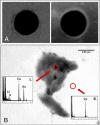A tale of two oxidation states: bacterial colonization of arsenic-rich environments
- PMID: 17432936
- PMCID: PMC1851979
- DOI: 10.1371/journal.pgen.0030053
A tale of two oxidation states: bacterial colonization of arsenic-rich environments
Abstract
Microbial biotransformations have a major impact on contamination by toxic elements, which threatens public health in developing and industrial countries. Finding a means of preserving natural environments-including ground and surface waters-from arsenic constitutes a major challenge facing modern society. Although this metalloid is ubiquitous on Earth, thus far no bacterium thriving in arsenic-contaminated environments has been fully characterized. In-depth exploration of the genome of the beta-proteobacterium Herminiimonas arsenicoxydans with regard to physiology, genetics, and proteomics, revealed that it possesses heretofore unsuspected mechanisms for coping with arsenic. Aside from multiple biochemical processes such as arsenic oxidation, reduction, and efflux, H. arsenicoxydans also exhibits positive chemotaxis and motility towards arsenic and metalloid scavenging by exopolysaccharides. These observations demonstrate the existence of a novel strategy to efficiently colonize arsenic-rich environments, which extends beyond oxidoreduction reactions. Such a microbial mechanism of detoxification, which is possibly exploitable for bioremediation applications of contaminated sites, may have played a crucial role in the occupation of ancient ecological niches on earth.
Conflict of interest statement
Competing interests. The authors have declared that no competing interests exist.
Figures







References
-
- Vaughan DJ. Arsenic. Elements. 2006;2:71–75.
-
- Lebrun E, Brugna M, Baymann F, Muller D, Lièvremont D, et al. Arsenite oxidase, an ancient bioenergetic enzyme. Mol Biol Evol. 2003;20:686–693. - PubMed
-
- Oremland RS, Kulp TR, Blum JS, Hoeft SE, Baesman S, et al. A microbial arsenic cycle in a salt-saturated, extreme environment. Science. 2005;308:1305–1308. - PubMed
-
- Ouzounis CA, Kunin V, Darzentas N, Goldovsky L. A minimal estimate for the gene content of the last universal common ancestor—exobiology from a terrestrial perspective. Res. Microbiol. 2006;157:57–68. - PubMed
Publication types
MeSH terms
Substances
LinkOut - more resources
Full Text Sources
Medical
Molecular Biology Databases

